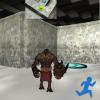Source from DigiPen :
In the past, Luedke has been something of a game project “fixer.” For example, about five months before Microsoft’s Forza Motorsport 2 racing simulator was scheduled to ship in 2007, the game was running at an unplayable two frames per second. As a performance expert within Microsoft Game Studios’ shared technology group, Luedke went in to try and rescue the project. He found the developers had been creating the game’s interconnected systems in isolation, with little to no regard for the game’s overall performance.
“There was one person who went and built the mini map system, or one person who built the skid-marks-on-the-track system,” Luedke says. “And then when they finally had to get their first playable prototype together, everybody kind of turned on all the systems at once.”Fortunately, through cutting certain features and optimizing others, Luedke managed to help the team bring the game back up to speed (in this case, 60 frames per second). And Forza 2 went on to be a commercial and critical success.
So is the strategy to not turn all system at once but to turn them when they need to be for the game to run 60 fps? I only have 1 month experience with game programming in Java but I found this fascinating of how they go about optimizing the game's performance. Is this anything remotely the same if someone programmed a 2d or 3d game in Java and wanted to optimized its performance in speed?







